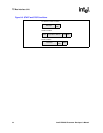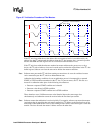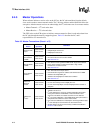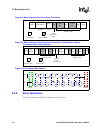
Intel® PXA255 Processor Developer’s Manual 9-9
I
2
C Bus Interface Unit
In master-transmit mode, if the target slave-receiver device cannot generate the acknowledge pulse,
the SDA line remains high. The lack of an acknowledge NAK causes the I
2
C unit to set the
ISR[BED] bit and generate the associated interrupt when enabled. The I
2
C unit automatically
generates a STOP condition and aborts the transaction.
In master-receive mode, the I
2
C unit sends a negative acknowledge (NAK) to signal the slave-
transmitter to stop sending data. The ICR[ACKNAK] bit controls the ACK/NAK bit value that the
I
2
C bus drives. As required by the I
2
C bus protocol, the ISR[BED] bit is not set for a master-
receive mode NAK. The I
2
C unit automatically transmits the ACK pulse after it receives each byte
from the serial bus. Before the unit receives the last byte, software must set the ICR[ACKNAK] bit
to 1 (NAK). The NAK pulse is sent after the last byte to indicate that the last byte has been sent.
In slave mode, the I
2
C unit automatically acknowledges its own slave address, independent of the
value in the ICR[ACKNAK] bit. In slave-receive mode, an ACK response automatically follows a
data byte, independent of the value in the ICR[ACKNAK] bit. The I
2
C unit sends the ACK value
after it receives the eighth data bit in a byte.
In slave-transmit mode, the I
2
C unit receives a NAK from the master to indicate the last byte has
been transferred. The master then sends a STOP or repeated START. The ISR[UB] bit remains set
until a STOP or repeated START is received.
9.4.4 Arbitration
The I
2
C bus’ multi-master capabilities require I
2
C bus arbitration. Arbitration takes place when
two or more masters generate a START condition in the minimum hold time.
Arbitration can take a long time. If the address bit and the R/nW are the same, the arbitration
scheme considers the data. Because the I
2
C bus has a wired-AND nature, a transfer does not lose
data if multiple masters signal the same bus states. If the address and the R/nW bit or the data they
contain are different, the master signals a high state loses arbitration and shuts off its data drivers. If
the I
2
C unit loses arbitration, it shuts off the SDA or SCL drivers for the rest of the byte transfer,
sets the ISR[ALD] bit, and returns to slave-receive mode.
Figure 9-5. Acknowledge on the I
2
C Bus
1
2-7
8
9
SCL from
Master
Data Output
by Receiver
Data Output
by Transmitter
Clock Pulse
for Acknowledge
SDA released
SDA pulled low
by Receiver (ACK)
Start Condition
∼
∼
∼
∼
∼
∼
∼
∼
(SDA)
(SDA)


















